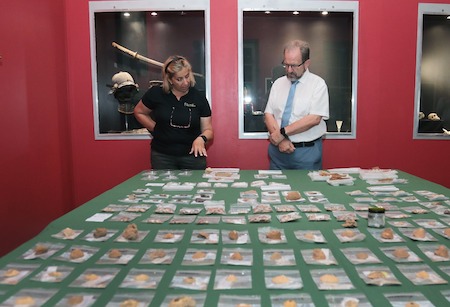The Gibraltar National Museum has been excavating in Gorham’s and Vanguard Caves for four months, from May until now.
Work proceeded in Gorham’s Cave until early August and in Vanguard Cave throughout. The most exciting results have come from an unsuspected area by the beach to the north of Vanguard Cave. This is the area of a remnant sea cave which has now been named “The Neanderthals’ Grotto”. It is the first cave in Gibraltar that carries the name of the Neanderthals and is a testimony to these people who, on present evidence, were the first to have lived on the Rock and made it their home.
Press were invited to a preview of the finds that have been made during these four months and particularly those from The Neanderthals’ Grotto. This site is now the tenth with evidence of Neanderthal occupation on the Rock, an incredibly high density of 1.5 sites per square kilometre. It is also the fifth occupation site within the UNESCO World Heritage Site itself. This was truly “Neanderthal City”.
The discoveries made are important because of the high density of artefacts that have been found and what they may reveal about the lives of these people. It is too early to appreciate the full extent of the discoveries, which will take months of laboratory work to untangle, but the evidence so far points towards:
(a) the strong possibility that we have found the oldest levels of Neanderthal occupation in Gibraltar, which may well predate the oldest published evidence so far of 127 thousand years ago. Samples have been taken for dating and we must await these results before confirming this to be the case;
(b) the large number of limpet, other marine shells and fish, associated with stone tools, points at a culture that looked towards the sea as a rich source of nutrients. Previous discoveries in Vanguard Cave have shown that Neanderthals also exploited Monk Seals, Common and Bottlenose Dolphins, but the density of limpet shells now indicates that this exploitation of resources was far from casual and was, instead, very much a part of their lives;
(c) the discovery of the skeleton of a raptor, probably a large owl, in anatomical connection is extremely rare. Associated with it were stone tools, limpet shells, herbivore teeth and mammal bones. It raises the question of why this bird was left there and why it had been taken. Work on this unique specimen will now proceed in the museum’s laboratories in an attempt to unravel the mystery;
(d) the discovery of part of an extremely large deer antler is also enigmatic. Why was this brought back to this site? Was it a trophy? Did it have a specific meaning to these people? This specimen is being conserved prior to study, given its fragility; and
(e) an array of stone tools made by the Neanderthals has been excavated in association with these specimens. Some of these are beautifully made and are among the finest discovered in these caves.





